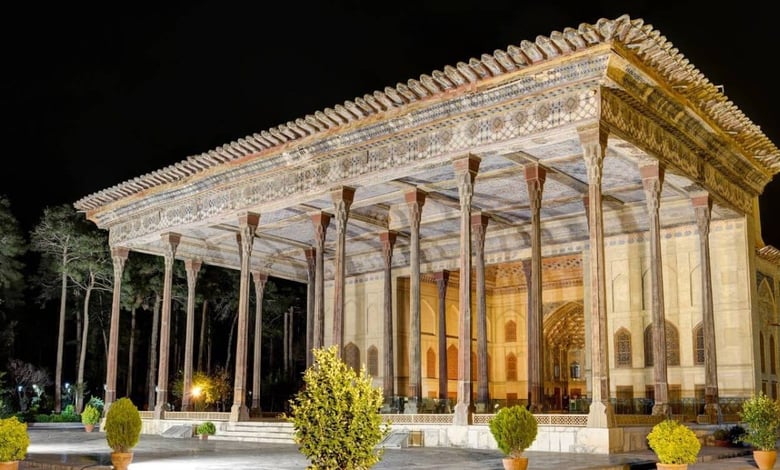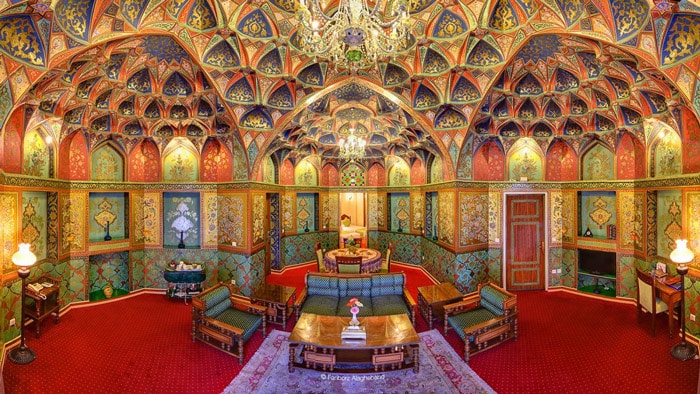Chehel Sotoon Palace in Isfahan: Everything to Know
A Majestic Masterpiece of Persian Architecture

Chehel Sotoun (Chehel Sotoon) Palace, a historic monument in Isfahan, Iran, stands as a striking symbol of the Safavid era’s architectural ingenuity and Persian artistry. Constructed in the mid-17th century under the reign of Shah Abbas II, this elegant edifice is renowned for its distinctive name, which translates to “Forty Columns,” derived from the reflection of its twenty slender wooden columns in the palace’s adjacent water feature, creating an illusion of forty.
Set amidst the lush landscape of a well-manicured garden, the palace is adorned with intricate frescoes, exquisite tile work, and grand murals that vividly narrate historical scenes and Persian court life, making it an essential site for understanding Persian culture and history. Chehel Sotoun, now a designated UNESCO World Heritage site, serves as a testament to the grandeur of Persian architecture and the rich cultural heritage of Iran.
Contents
Beautiful Isfahan
Isfahan is one of the cities with the most significant number of well-preserved palaces and historical places built during the Safavid Era, all of which are among the best examples of Persian architecture. Chehel Sotoon Palace is one of these exceptional locations.
This relatively small palace was built in the middle of a beautiful garden, which is among the nine Persian gardens registered by UNESCO as a World Heritage. Built by Shah Abbas II during the 17th century, the palace was used to receive dignitaries and organize various receptions. As a result, Chehel Sotoon Palace is an exceptional combination of architectural and ornamental techniques, while also displaying a rich collection of paintings.
A Brief History of Chehel Sotoon Palace in Isfahan

The history of Chehel Sotoon Palace starts with the first king of the Safavid Empire, Shah Abbas I, known as Shah Abbas the Great. At the end of the 16th century, the king of the newly established dynasty decided to move the capital of his empire to Isfahan, for the second time in the history of Persia, changing the fate and the face of the city. This started the golden age of Isfahan.
Shah Abbas I started many huge construction projects to modernize the historical city. One of the emblematic projects was the construction of the Chahar Bagh Avenue, a large boulevard that would be surrounded by several gardens. The most important of these gardens was the one that is now Chehel Sotoon Palace, as it would connect Chahar Bagh with Naqshe Jahan Square.
With a great location near Ali Qapu Palace, where the Safavid court carried out its duties, this garden made it a perfect location for the king, which ordered the construction of a pavilion mansion. It is said that the mansion was pretty modest, far from the glorious building we can now admire, but it was still eventually used to receive foreign diplomats and important guests, as well as organizing gatherings and modest celebrations. In 1614, historical records show that king Shah Abbas I celebrated Nowruz, the Persian New Year, in that mansion.
This pavilion was thus the first foundation of what would become Chehel Sotoon Palace.
In the mid-17th century, Shah Abbas II, the seventh king of the Safavid Dynasty, decided to transform this mansion into a palace. It was thus expanded with several halls and chambers. Most of the opulent decorative structures, such as wooden columns, mirror-work, and painted ceilings, were also added by Shah Abbas II, who, similarly to his ancestor, would use this palace to receive ambassadors and important guests.
Signification of Chehel Sotoon’s Name

Literally, Chehel Sotoon means “Forty Columns” in the Persian language. There are several interpretations of the name of this palace. The most common is that the addition of the 20 wooden columns of the porch to their reflection in the pool would create this “Forty Columns Palace”.
However, it’s interesting to note that in Persian literature, “forty” is used to express the multiplicity and does not necessarily have to be interpreted as the exact number. Thus, the name could also express the idea of a palace with a multitude of columns.
Architecture of Chehel Sotoon Palace in Isfahan

While modest in size, Chehel Sotoon Palace in Isfahan is an architectural and decorative masterpiece. It is said that the architecture and design were inspired by Chinese, Indian and European styles.
The most striking feature of the palace is its elegant high porch, supported by 20 columns made of sycamore and pine wood, the top of each richly decorated. This octagonal porch is 38 meters long, 17 meters wide and 14 meters high. In the middle of the porch, four of the columns sit on beautifully carved stone lions.
Looking more closely, one can see that the porch actually consists of two parts. The main section is based on 18 of these wooden columns, all 14 meters high. The second part, slightly higher, forms the entrance of the hall. Richly decorated with mirror-work, it is sometimes called the Mirror Hall.
Following this porch is the main hall, the most important part of Chehel Sotoon Palace. While the ceiling of the porch was spectacularly decorated with porcelain knots, paintings and mirrors, the main hall is also a masterpiece. It is decorated with beautiful paintings and frescos on the walls and ceiling, along with inlaid windows. The paintings are among the best examples of the Isfahan School of Painting and Reza Abbasi’s work (the most famous painter of Shah Abbas I’s court).
Eventually, one of the important features of the palace is its long pool that is in front of the palace, and in which the porch and columns are reflected.
Chehel Sotoon Palace Nowadays
After the fall of the Safavid Empire, the palace was gradually left unattended under the Qajar Era, like many other historical palaces. Hopefully, it didn’t suffer much damage and during the Pahlavi Dynasty, an Italian archeological institution was commissioned to renovate Chehel Sotoon Palace.
In 2011, the palace was inscribed as a World Heritage site by Unesco for being one of the best examples of Persian Gardens. Nowadays, the Palace has been turned into a museum and can be visited by travellers from all over the world.

Access to Chehel Sotoon Palace in Isfahan
Chehel Sotoon Palace is located between Chahar Bagh Avenue and Naqshe Jahan Square, in the city center of Isfahan. It can be easily accessible by bus, metro and taxis. There metro station Meydan-e- Emam Hossein is located a few meters away from the entrance of the palace.
Cost and Suggested Visit Time for Chehel Sotoon Palace
Chehel Sotoon Palace is open every day from 8:30 AM to 4 PM. The entrance fee for foreign visitors is only 1.000.000 rials (about 2 € as per the rate of November 2023).
Nearby Attractions to Chehel Sotoon Palace in Isfahan
Located in the city center of Isfahan, Chehel Sotoon Palace is one of the many city’s highlights. It is near another palace, Hasht Behehst, situated just a few meters away. It is also at a short distance of Naqshe Jahan Square (Unesco) where you can visit the Shah Mosque, Lotfollah Mosque, Ali Qapu Palace and explore the Grand Bazaar. The famous Sie o Se Pol bridge is located south of Chehel Sotoon Palace and can be reached with a 30-minute walk on the famous Chahar Bagh avenue.

Hotels Near Chehel Sotoon Palace in Isfahan
Given the central location of Chehel Sotoon Palace, it’s easy to find a good accommodation nearby, whatever is your budget. Here are our favorite ones near Chehel Sotoon Palace:
- Ghasr Monshi Hotel
- Abbasi Hotel
- Keryas Hotel
- Isfahan Traditional Hotel
- Parsian Kowsar Hotel
- Aseman Hotel
Nearby Restaurants to Chehel Sotoon Palace
There are lots of restaurants and cafes around Chehel Sotoon Palace where you can find both street food and traditional local dish. Don’t forget to try Biryani, the most typical Isfahani dish, made with meat. Here are our recommendations for restaurants and cafes near Chehel Sotoon Palace:
- Chehel Sotoon Traditional Teahouse
- Azadegan Tea House and Restaurant
- Emarat Namakdan Cafe
- Meydoon Cafe
- Sogoli Cafe and Restaurant
Read More




